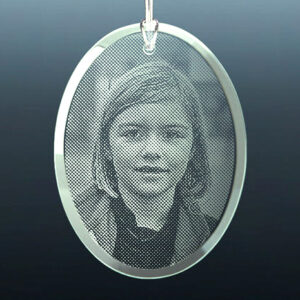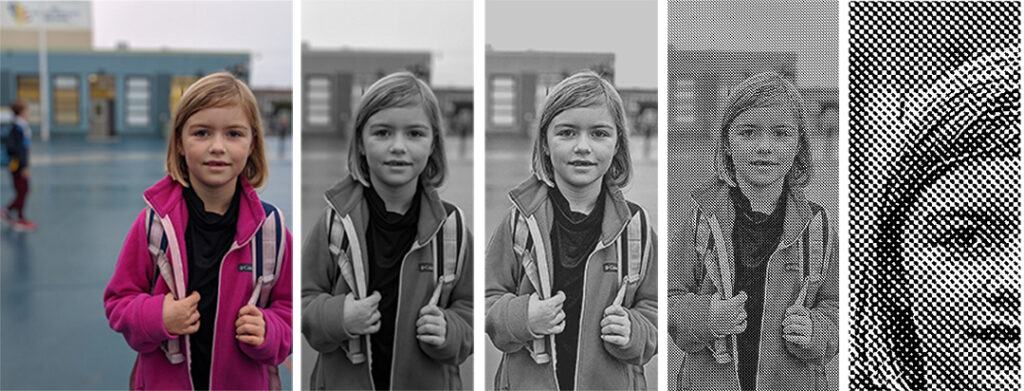Photo Etching
Understanding Photo Etching
Photographs require a different process to be able to replicate gradients and tonal differences in your image. To achieve a photograph etching we convert the image into a halftone screen. A screen looks like small dots if inspected up close but makes your eye see the photograph unless examined closely. The screen uses a fine pattern of printed dots to give the effect of shading. this is also the process used for photos printed in a newspaper.


above you see the etched suncatcher ornament followed by the original the original photo and the steps used to get to the halftone image used for the final etching.
1st) Original color photo as provided
2nd) Original photo converted to black & white
3rd) Photo after sharpening and enhancements to bring out the details
4th) Enhanced photo after applying the half tone screen
5th) Close up of half tone image.
Photographs are unique and some photos replicate into a screen process better than others. Until an image is screened and etched we can not know what the exact end result look will be. Based on our experience we can offer our opinion on whether an image will or will not turn out well and make recommendations based on our expertise.
The process to convert a photograph into a screen requires extra time and effort and as such we must charge an additional fee to add a photo to your design. Adding a photograph to your design will add an additional $20 to your basic etching fee. You may be charged more if your image is over sized or unusually complex.
How to choose a Photo for Etching
Supply us with a high resolution photograph or digital image. Images that are blurry or low resolution will not work well. We can scan a printed image for you, if your image was taken with a digital camera or phone email us the file, do not print it out on paper.
Do not take a photograph of a photograph or a printed image with your phone .
Please bring us the image to scan or use a scanner and then email us the file.
We can use both color and black and white images.
Photographs that have busy backgrounds or people wearing clothing with an intricate pattern generally do not etch well.
• For this reason a person with dark hair on a dark background may not show up well unless there is a lot of highlights created from the way the photo is lit.
• Subjects that are well lit from the front will make t he best etchings.
• Backlit subjects look flat and often the background appears more important than the subject.
• Photos with good contrast between the light and dark areas look best.
• I will always try to compensate for shortcomings of the photo but the better suited the photo is from the beginning the better the overall etching will be.
We can not guarantee that an image will replicate perfectly. Each image is unique and due to color shading and contrast variations some photos may not etch well. This is especially true for images that you may want to be very small. The smaller the image to be etched the more the fine details will be lost. Sizing recommendations will be made if we believe your image is too small.
Each item of glass that we etch is hand sandblasted, if you order multiples of a product with a photograph there will be variations in the etches and this is not a flaw of the process, each item is a unique piece of handmade art.
Points to Remember when Etching Photos
- Look for good contrast between lights and darks
- Subject should be well lit
- Back lighting makes the background look more important than the subject
- Subjects in shadow look flat and lack details
- Only light areas are etched – Very dark areas will be clear glass
- Viewing photos with a black and white filter will provided better visualization
- The smaller an image is etched the less details will be visible

